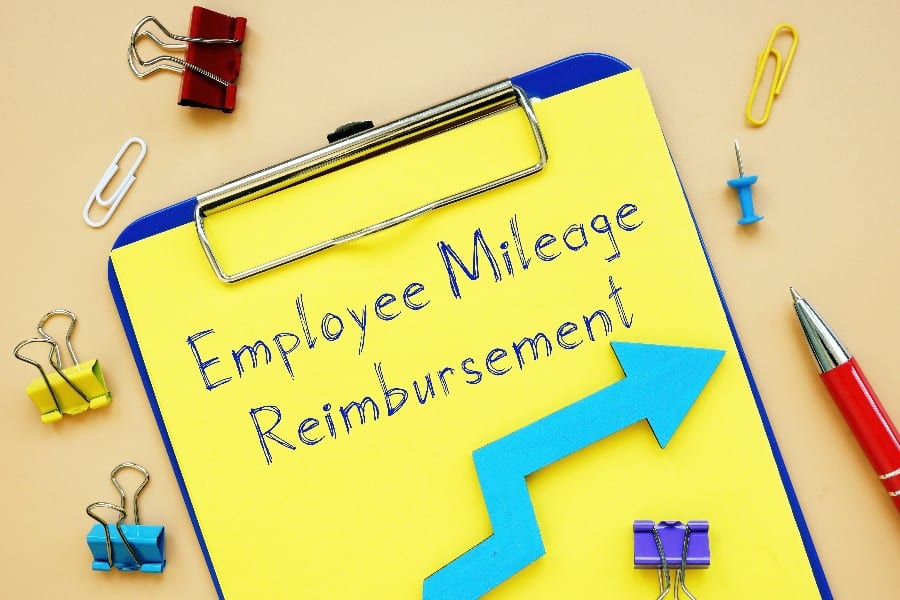
Employee mileage reimbursement is when a business pays a certain amount to cover the expenses (cost of gas, oil changes, and other maintenance) of an employee using their personal vehicle for work-related purposes. As such, employers recognize the importance of compensating employees for the time and resources spent traveling for work-related purposes.
Key Takeaways:
- Paying employee mileage reimbursement can positively impact morale, productivity, and the company’s bottom line.
- Mileage reimbursements are an addition to an employee’s salary.
- Wages minus out-of-pocket expenses for work-related purposes cannot fall below the federal minimum wage.
The IRS has set a standard for mileage reimbursement for employees (67 cents per mile), however, you are free to use any amount you wish. If you pay more than the standard rate, employees will be taxed on the excess amount. Use our mileage reimbursement calculator to compute your employee’s mileage reimbursement and the total taxable amount (if you reimburse more than the IRS standard rate).
Employee mileage reimbursement is calculated by multiplying the number of miles by the rate per mile. Below is an example of how to calculate business mileage reimbursement for employees.
Employee Mileage Calculation Example
Total Miles Driven: 100
Reimbursement Rate: $0.67 per mile
100 x 0.67 = $67.00
The Internal Revenue Service (IRS) has set a current employee mileage reimbursement rate of 67 cents per mile, which is what we recommend employers use (although you can offer more or less). This isn’t considered income by the IRS unless you offer more than the standard IRS rate. In that case, the difference between the IRS amount and what you offer will be taxable income for the employee. Any amount you pay to employees is also tax deductible for your business.
*Note: only the amount above the standard rate is taxable, not the entire reimbursement. For instance, if you pay 87 cents per mile only 20 cents per mile is taxable.
Using payroll software, such as Gusto, can make mileage reimbursement calculations easier. Reimbursements can be paid quickly through payroll, following manager approval. Plus, you can run reports to see a history of all mileage reimbursements processed. Sign up today and get one month free when you run your first payroll. Offer will be applied to your Gusto invoice(s) while all applicable terms and conditions are met or fulfilled.
Qualified Mileage Reimbursement
Many businesses have questions about what qualifies for mileage reimbursement for employees. Think of it this way: any driving in an employee’s personal car that’s done for work-related purposes, other than their commute, could be a qualified mileage reimbursement.
Here are some examples:
- Business trips where the employee drives to another city
- Meeting with clients in town (even if the drive is shorter than their normal commute)
- Meetings with prospective clients at your office, the client’s office, a coffee shop, or any other location
- Running company errands
- Making deliveries to employees, clients, or other office locations
Non-qualified Mileage Reimbursement
There are two items that work mileage reimbursement isn’t intended to cover: tolls and parking expenses. If your employees drive in a city with toll roads or where they regularly have to pay to park, you’ll need to reimburse them those costs outside of the mileage reimbursement rate. These amounts will be tax deductible for you and not income to your employees.
You only need to reimburse reasonably necessary expenses—meaning that the travel being paid for must have been economical and appropriate. If an employee runs an errand for your company and chooses to drive an extra 20 miles for a more “scenic” route, then you’re only required to reimburse the employee on the mileage calculated based on the shortest distance.
How to Create a Mileage Reimbursement Program
Developing a mileage reimbursement program allows you to clearly outline expectations to employees, determine rates, and have a policy in place. Follow the steps below to create your program:
- Determine rate: Although we generally recommend sticking with the IRS mileage reimbursement rate (currently 67 cents per mile), you are free to pay more or less. Understand, however, that offering a higher rate will trigger payroll taxes, and the amount above the IRS rate will be counted as income to the employee.
- Decide how often to pay mileage reimbursements: We recommend you pay once per month on a regular payroll day. Doing it just once per month still gets employees their reimbursement in a reasonable time while also giving your payroll team time to process each reimbursement request before paying it out.
- Create a policy: Your policy should include the mileage reimbursement rate your company uses, what trips qualify for mileage reimbursement, how employees should calculate and record their mileage, the reimbursement request process for employees, and how and when mileage reimbursements will be paid. This policy should be part of your permanent employee handbook. Since the rates may change from year to year, it is recommended that you include this as an addendum.
- Verify mileage reimbursement requests: For each request, you must verify how much mileage you need to reimburse. For security, you can have employees take a picture of their odometer before and after every work trip and have them submit those photos to you attached to the form requesting mileage reimbursement.
- Approve requests: When you or the employee’s manager approves the request, it should go to your payroll team to process. You’ll want to make sure they check the calculation to make sure it’s correct. They’ll also need to ensure they mark the payment as a mileage reimbursement so neither your company nor your employee are taxed.
- Submit reimbursements: Once the request is approved, you will need to pay the employee for the mileage reimbursement. We recommend submitting all reimbursements through your regular payroll. Unless the amount is higher than the standard IRS rate, your employee will not be taxed on this reimbursement.
Legal Considerations for Mileage Reimbursements
While the IRS releases an updated mileage reimbursement rate each year, there is no federal requirement for employers to offer employees mileage reimbursement. Three states, however, do require it: California, Illinois, and Massachusetts. Other states may even require employers to reimburse for other expenses, like tolls.
That said, you should keep in mind two other areas of the law when dealing with employee mileage reimbursement: minimum wage law and tax law.
Under the Fair Labor Standards Act (FLSA), you’re required to pay employees at least minimum wage, which is currently $7.25 per hour (this may be higher depending on the state or city). If you don’t reimburse for business use of an employee’s personal vehicle, and that employee’s pay falls below the minimum wage because of it, you could face legal trouble. In that case, you’d be required to reimburse your employee’s out-of-pocket expenses or work mileage reimbursement to ensure their pay at least meets the federal minimum wage.
Minimum Wage & Mileage Reimbursement Example
Any amount you pay to an employee beyond actual costs or the IRS standard is taxable as income. Even if you don’t use the IRS rate for your company’s reimbursement policy, you’ll still need to use it to calculate the non-taxable amount—then any amount paid on top of that will be considered taxable. That’s one reason we recommend simply using the IRS reimbursement rate as the cleanest solution for payroll compliance.
Tax Law & Mileage Reimbursement Example
Employee Mileage Reimbursement Frequently Asked Questions (FAQs)
It is recommended that you pay the standard IRS mileage reimbursement rate, currently at 67 cents per mile. However, it is not required, and therefore, you can pay as much or as little as you deem appropriate.
No. Mileage reimbursements are in addition to an employee’s salary. It should be noted that this only applies to rates at or below the IRS standard mileage reimbursement rate. If you choose to reimburse at a higher rate than the standard, then anything over the standard rate is taxable and is therefore considered part of an employee’s salary.
The easiest way is to have employees keep a log every time their personal vehicle is used for work-related purposes. Additionally, you can have them take a photo of their odometer before and after a work-related trip.
Bottom Line
While not a federal requirement, offering mileage reimbursement for employees’ use of their personal car for business purposes is a good policy. Using the IRS mileage reimbursement rate, the amount you pay is tax deductible for your business and non-taxable income for your employees, making for a great addition to your company benefits package.





